정세라 개인전
JEONG Se-Ra Solo Exhibition
2010. 12. 01 ~ 2010. 12. 14.
정세라
JEONG Se-Ra
-

Beyond, 91x72.7cm, Oil on canvas, 2010
-

Blue room, afternoon, 41x31.8cm, Oil on canvas, 2008
-
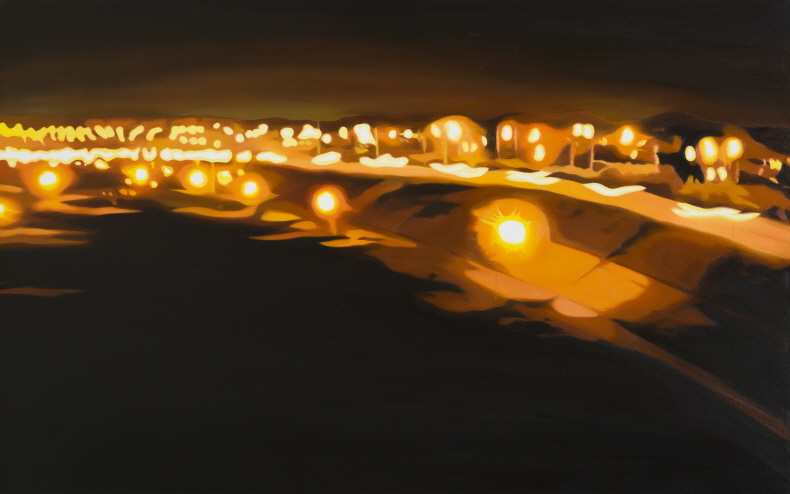
Crossing over Darkness, 116.7x72.7cm, Oil on canvas, 2007~2010
-
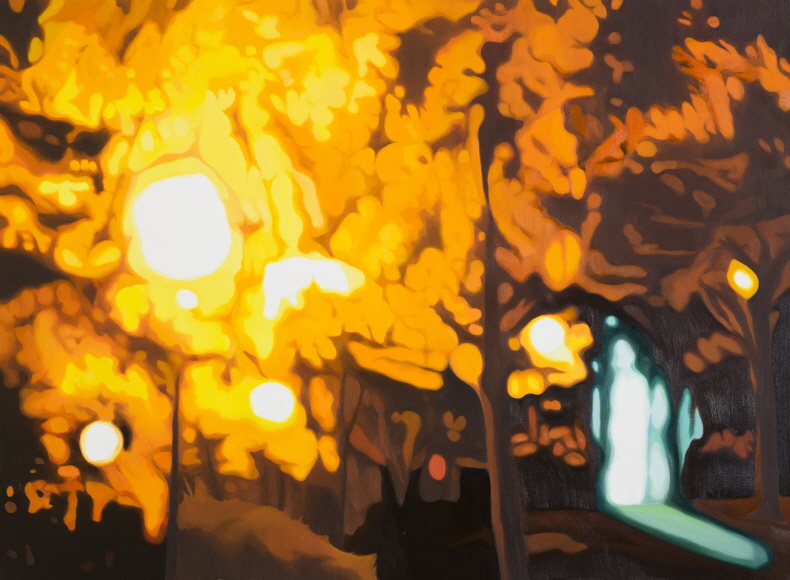
hallway, 72.7x100cm, Oil on canvas, 2010
-
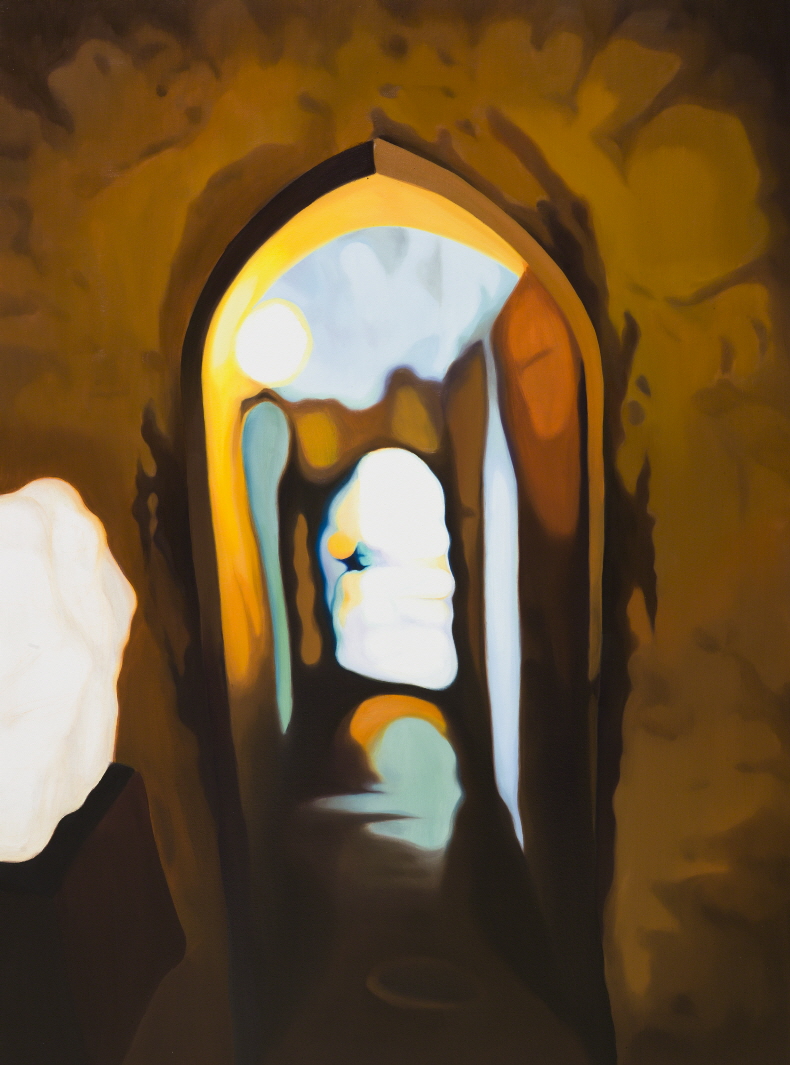
hallway, 100x72.7cm, Oil on canvas, 2010
-
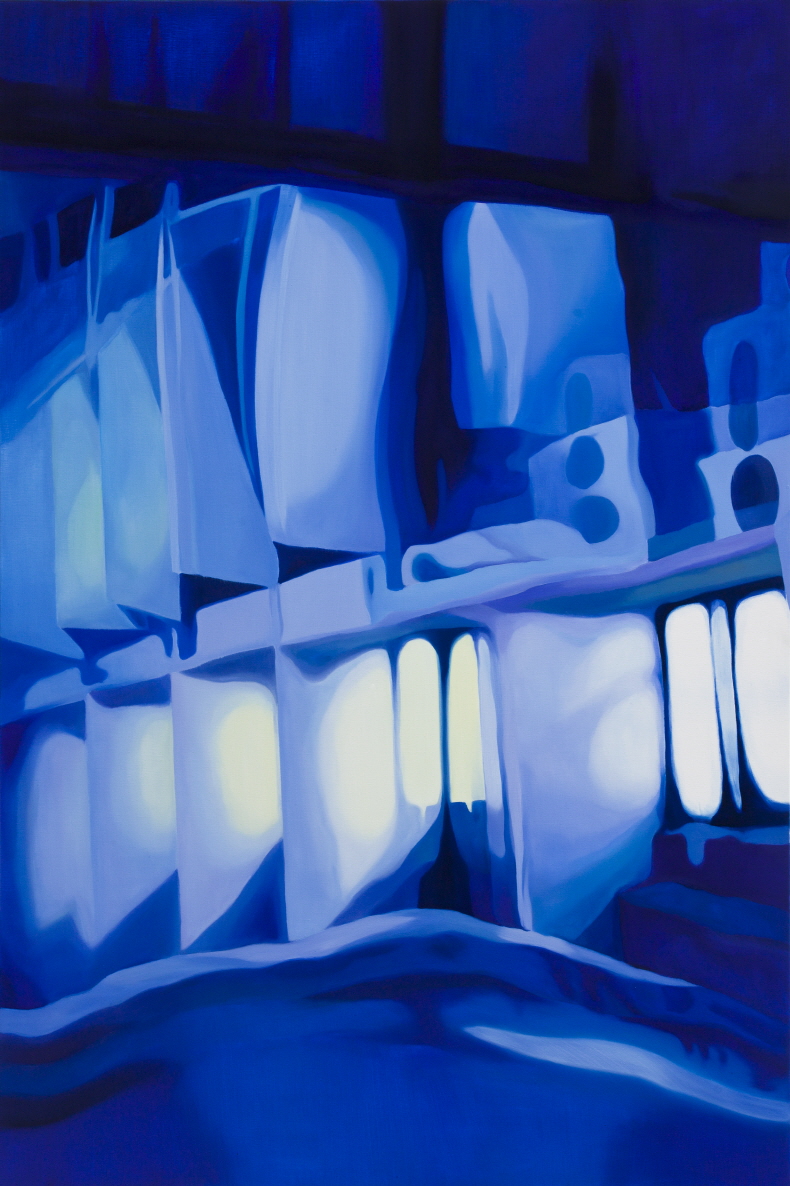
house without exterior, 145.5x97cm, Oil on canvas, 2010
-

house without exterior, 162x112cm, Oil on canvas, 2010
-
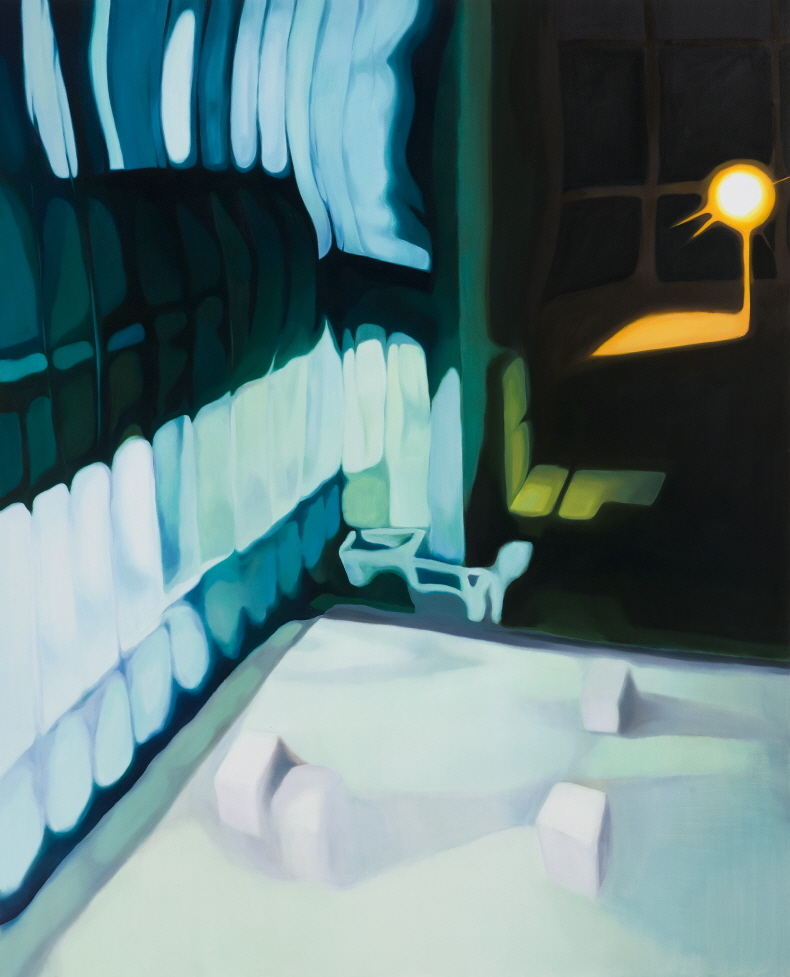
house without exterior, 162x130.3cm, Oil on canvas, 2010
-
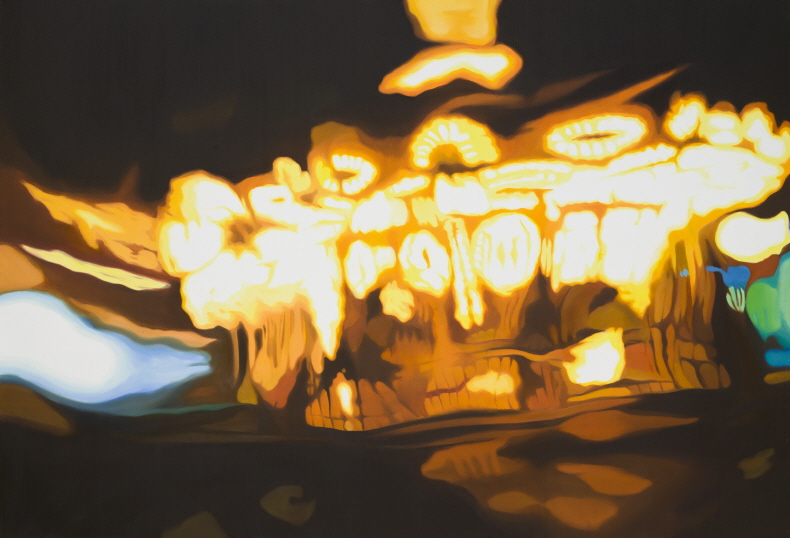
in the park, 80.3x116.7cm, Oil on canvas, 2010
-
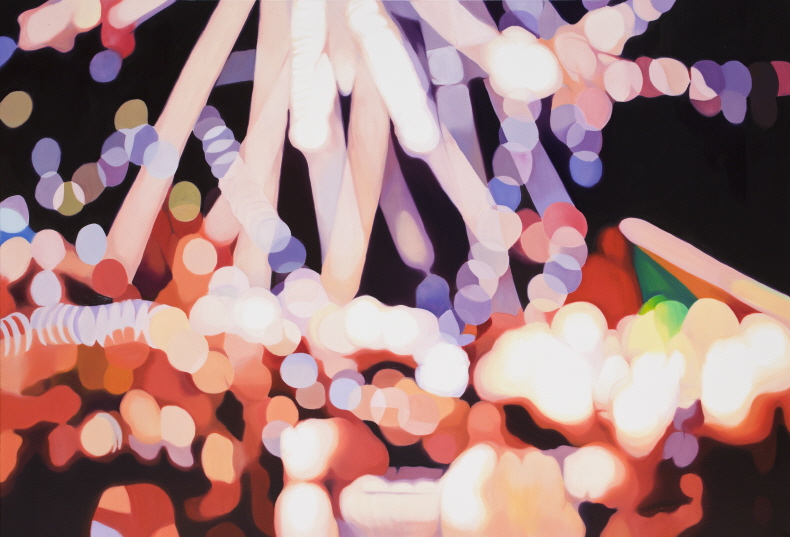
in the park, 116.7x80.3cm, Oil on canvas, 2010
-

in the park, 116.7x91cm, Oil on canvas, 2010
-

in the park, 116.7x91cm, Oil on canvas, 2010
-
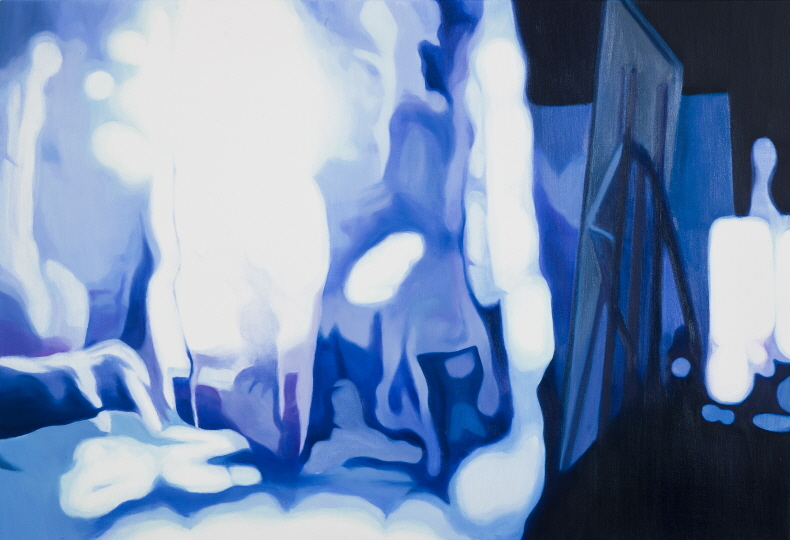
self-portrait, 50x72.7cm, Oil on canvas, 2010
-
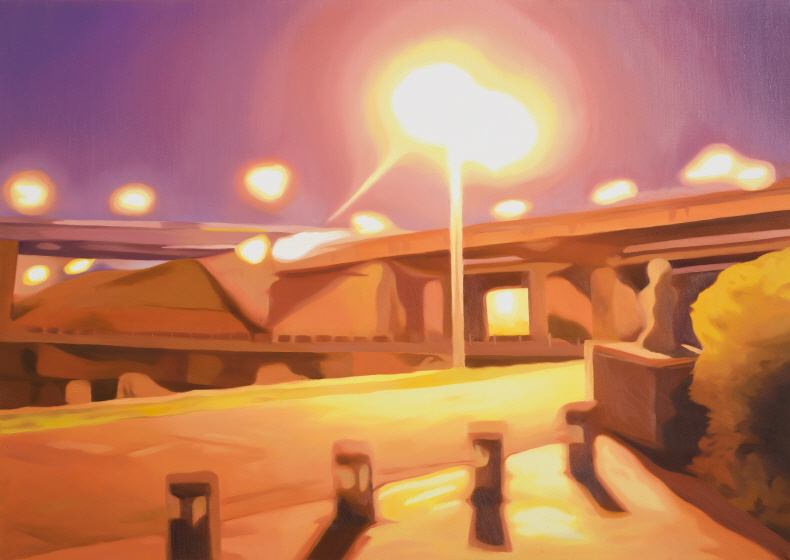
Standing under Light, 72.7x91cm, Oil on canvas, 2010
- KR
- EN
About Exhibition
낮 속의 밤, 또는 밤 속의 낮
이선영 (미술평론가)
정세라 전에서 미로의 구조를 떠오르게 하는 ‘외부 없는 집 ’이라는 전시부제는 유리나 금속 같은 반사면에 의해 건물 안팎의 구별이 모호해진 현대적 공간에서 출발한다. 건축 재료와 공법의 혁명적인 발명이 이루어진 근대 이래로, 고층빌딩이나 아케이드로 대변되는 현대 건축은 어두침침하고 눅눅하며 묵직한 건축의 전통을 벗어나서, 창공을 향해 날아오르려는 날렵한 외관으로 그 안팎을 투명하게 개방하였다. 철과 콘크리트를 뼈대로 하고 유리창으로 뒤덮인 현대건축은 자연광과 인공광과 어우러져 자신의 물질성을 벗어나 있으며, 이전 같았으면 벽과 지붕 등으로 분리되었을 여러 공간들을 종횡으로 가로질러 확장된 장으로 변모시킨다. 이전 시대의 거추장스러운 장식을 걷어내고 중심과 주변의 관계를 투명하게 드러내는 근대 건축은 외부로부터의 도전이 아니라, 그 자체의 논리를 가속화시킴으로서 다시금 불투명한 것으로 바뀐다. 그 역설적 운명은 자유에서 시작하였지만 쇠우리로 귀결된 근대적 계몽(enlightenment)의 여정과 함께 한다.
근대에서 탈근대로의 국면 전환과 교차될 수 있는, 투명함에서 불투명함으로의 전이는 자연과 인공 광원에 민감하게 반응하는 표면들에 의해 강화된다. 빛은 견실한 구조의 중심과 주변 관계를 모호하게 하고 직선을 휘게 하며, 밑도 끝도 없는 표면의 흐름으로 전치시킨다. 빛과 어둠 사이에서 요동치면서 도시환경을 이루는 견고한 모든 것들이 이그러지고 흔들거린다. 투명하고 각진 구조로 가득한 도시는 왜곡과 변형을 거쳐 액화되며, 푸른 색조의 깊은 멜랑콜리에 잠겨 있다. 반면 노랑 빛의 나트륨 등이 켜지기 시작하는 밤이 되면, 주변은 녹아내리고 폭발할 듯한 분위기로 변모한다. 멜랑콜리이든 조광증이든 거기에는 강렬한 심리상태가 투사되어 있다. 정세라의 풍경에는 현실과 욕망이 구별할 수 없을 만큼 얽혀 있다. 환상적으로 보이지만 현실로부터 출발했다는 느낌이 남아있으며, 그로테스크하지만 서정적인 아름다움 또한 남아있다. 형식적인 면에서 그녀의 작품은 임의적 장식으로 전락할 수 있는 추상으로 귀결되지 않으며, 내용적인 면에서 기괴함을 위한 기괴함에 매몰되지 않는다. 정세라의 그림은 이 미묘한 경계 지대에 걸쳐 있다.
1,2층으로 나뉘어 전시된 20여점의 그림은 푸른 색조의 도시 풍경과 노랑 색조의 도시 외곽 지대 풍경으로 구별될 수 있다. 도시풍경의 경우, 흔히 낮과 밤에 기대되는 바의 감성과는 반대이다. 정세라의 작품에서 낮은 사물들의 차이를 구별하게 하는 명백함이 부족하며, 밤은 사물들을 부드럽게 감싸 안는 총체성이 없다. 풍경들은 낮이든 밤이든, 빛을 머금은 색조에 푹 젖어 있거나 발광(發光, 또는 發狂)한다. 도시풍경에서 깊은 푸른색은 심연처럼 모든 것을 삼켜버리며, 휴식을 모르는 밤의 빛(야간조명)은 모든 것을 무정형의 파편들로 갈기갈기 찢어버린다. 낮의 침묵과 밤의 비명이 번갈아가며 들려오는 정세라의 그림에는 섞임과 분열, 또는 침잠과 폭발이 공존한다. 그녀의 그림은 공간의 안팎의 관계가 불분명할 뿐 아니라, 시간 또한 그렇다. 분명히 풍경이긴 한데, 낮인지 밤인지, 여름인지 겨울인지 불확실한 경우가 비일비재하다. 가령 같은 작품이라도 건물 안에서 밖을 보는 시점으로 가정하면, 이리저리 휘어진 그리드 구조의 창틀에 걸쳐 있는 빛의 뭉치는 낮의 지표인 자연광으로 판단된다.
반대의 시점으로 가정하면, 빛은 어둠이 깔린 밖에서 들여다보이는 실내의 인공 광으로 간주될 수 있다. 미묘한 경계 영역에서 매순간 유동적인 작품들에서 거의 유일하게 직선이 보존된 작품이 있으니, 그것은 작업실에서 작업하는 자화상이다. 창밖에서 실내로 쏟아지는 빛에 의해 인간을 포함한 모든 것이 뭉글거리는 와중에도 캔버스만은 똑바로 서 있다. 불확실한 모든 것들을 담아내는 예술이라는 기준 만큼은 반듯한 것이다. 자유롭다는 착각으로 매사에 붕 떠 있는 낭만주의 풍의 작가 상과 달리, 정세라는 주간에 작업시간을 엄격하게 정해 놓고 그림에만 몰두한다. 모든 것들이 또렷하지 않고 흐릿하게 번지는 무정부 스타일의 작품 이면에, 회사원이나 과학기술자 못지않은 규칙적인 작업 패턴이 깔려 있다. 이렇게 서로 반대되어 보이는 것들의 공존과 상호침투는 작품의 핵심에도 놓여 있다. 도시에서 나서 도시에서 자란 작가의 이력을 반영하는 도시 풍경은, 한 치의 앞도 가늠할 수 없는 정글 같은 것으로 변모하고, 도시 외곽의 자연은 인간의 욕망으로 온통 빽빽하게 구조화 된다.
작품의 소재가 되는 참조대상은 분명히 존재하지만, 어디인지 잘 알 수 없다. 그러나 거기에 서있는 것들이 단지 상상의 대상이 아니라는 점은 매우 중요하다. 유리창이 촘촘한 기하학적 배열이 야기하는 차이와 반복, 그리고 빛과 어둠과 교차되는 안과 밖 공간이 특징적인 화려한 유리 건물들이 등장하는 도시풍경은 언제 어디서건 인적을 발견하기 힘들며, 건축물로서의 확고한 토대를 상실한 채 풍선처럼 공중에 붕 떠 있다. 정세라의 작품에서 육중한 모든 것들을 중력으로부터 탈피시키는 것은 빛이다. 철골 구조와 그 사이를 채우는 유리 피막은 출렁이는 그물망이 되어 시간도 공간도 모호한 실체를 부질없이 포획하려 한다. 이곳에서 저곳으로 이동하는 통로인 건물 사이의 계단은 그것을 밟는 자의 무게 중심을 여지없이 뒤흔들 것이며, 아우성치듯 우글거리는 끝없는 창문의 열은 결코 밖의 경관을 투명하게 보여주지 않을 것이다. 도시 외곽의 놀이공원 풍경을 그린 작품들의 시간대는 도시 풍경보다는 명확한 편이다.
그것은 인간의 필요와 욕망에 의해 심어지고 가꾸어진 조경수들을 칭칭 휘감는 전선줄에서 빛이 발하기 시작할 무렵이며, 행락객들이 썰물처럼 빠져 나간 야간 시간대나 비수기인 한겨울이다. 인적 뜸한 놀이공원의 모습은 무인지경의 도시 풍경처럼 스산하지만, 광원의 차이에서 비롯되는 상반된 분위기가 있다. 행락객들이 모두 일상으로 되돌아간 후 남겨진 자연과 오락 기구들은 여전이 불을 밝히고 있다. 오락가락하는 불안정한 욕망의 흐름을 소비라는 일련의 정해진 통로를 통해 회전시킴으로서 안정화하려는 자본의 전략은 밤의 휴식을 잊게 만들었던 것이다. 모든 것은 멈추지 않고 돌아가야 한다. 이 꺼지지 않은 조명들이 인위적으로 구조화된 욕망과 환상의 찌꺼기들을 기이한 것으로 변모시킨다. 놀이 기구들은 번지는 노란색 광원들로 흐릿하게 녹아 내려 무중력 상태로 부유하며, 정확히 무엇인지 알아보기 힘들다. 아무도 태우지 않고 불 켜진 채 홀로 회전하는 기구들은 마치 광인들을 가득 실은 술 취한 배처럼 흥청거리며 어디론가 항해하며, 회전목마의 부분을 그린 작품은 몸체에 불이 붙은 지도 모르는 채 예정되어 있는 궤도를 따라 질주하는 모습이 파국적이다.
놀이 공원의 모습을 그린 [in the park] 시리즈에서, 한 장소를 채우는 사물들은 어둠 속에서 명멸하는 폭죽처럼 색색의 빛 입자로 흩어진다. 자연의 운명도 마찬가지이다. 밤이라고, 겨울이라고 쉴 틈 없는 조경수들은 자신의 몸을 빈틈없이 옭아맨 인공조명에 의해 타오르고 있으며, 산란하는 빛은 무정형 단세포로 무한 분열한다. 난색의 물결 속에서 한색으로 또 다른 통로를 뚫어놓은 한 작품은 공원의 숲 다른 곳으로 이동하는 미지의 통로가 되어준다. 주변 환경과 구별되는 색감 때문인지, 이 구멍은 마치 대 재난의 현장을 벗어날 수 있는 비상구처럼 보인다. 무인지경 속에서 작동하는 기계들과 빛은 과도한 욕망을 넘어 전멸에 이르는 종말론적인 환상에 가까워진다. 한순간의 섬광으로 모든 것을 삼켜버릴 법한 강렬한 에너지가 있는 정세라의 그림은 우주적 심연 속에서 빛을 발한다. 여기에서 빛은 어둠 속에 묻힌 모호한 것들을 명명백백하게 비추는 진리라는 오랜 은유와 거리가 있다. 그것은 진리의 이면인 신비와 더욱 밀접하다. 그것은 근대 도시 건축의 투명성에서 미로적인 불투명성을 발견한 것과 마찬가지의 차원이다.
정세라의 작품은 명과 암, 거짓과 진리의 이항대립에 의존하는 이원론을 침식시킨다. 한스 블루멘베르크는 [진리의 은유로서의 빛]에서 인간을 완전하게 만드는 것은 더 이상 빛 속에 머무르는 것도 아니고 보는 것도 아니라고 말한다. 그 대신 인간을 추동하는 바는 빛 자체 속으로 들어가 보고, 여타의 가시적인 것들을 사라지게 한다는 관념이다. 절대적 빛과 절대적 어둠은 서로 맞아 떨어지게 된다. 시각은 이원론에 의존하는 전형적인 감각이다. 주체와 대상 사이의 일정 거리를 두고 작동하는 시각은 가장 정신적이고, 그래서 형이상학적인 사고와 곧잘 결부된다. 시각의 역사를 살펴보면, 이러한 형이상학 사고가 근대에 와서 근절된 것도 아니다. 신학과 곧 그 뒤를 잇는 휴머니즘에 내포된 이성의 빛은 통제되는 빛으로 급속하게 편입되었으며, 이러한 편입은 진보된 산업기술에 의한 것이다. 그자체가 새로운 발명품들의 전시장인 근대 건축들과 오락기구, 무엇보다도 인간세계로부터 밤을 쫒아낸 각종 인공광원들이 그것이다.
관조와 사유를 내포했던 조명(illuination)은 근대에 와서 동질적인 가시성의 매체로서, 생산 또는 소비되어질 대상에 집중적으로 주사되는 광선으로 축소되었다. 확장은 축소의 이면이었던 셈이다. 정세라의 작품은 궁색한 도구이자 편협한 이데올로기가 되어버린 재현의 선적 시각을 사정없이 엉클어 놓는다. 대상을 명확히 한정짓는 외곽선과 그것이 놓이는 분명한 좌표계를 나른하게 이완시켜 버림으로서, 플라톤의 이데아론부터 칸트의 선험철학에 이르기까지, 안정적이고 동질적인 형식을 창출하는 감각으로 기대되었던 견고한 시각성의 끄트머리를 드러낸다. 정세라의 작품에서 시각적인 것은 촉각적인 것이나 청각적인 것으로 화한다. 그것은 구름처럼 계속 뭉글거리며 잡으면 손에서 빠져 나갈 것 같고, 아주 차갑거나 뜨거울 것 같다. 또는 깊은 침묵 속에서 웅웅거리거나 눈이 멀 것 같은 강한 에너지를 방출하며 폭발음을 낼 것 같다. 존 맥컴버는 근대적 시각을 반성하는 논문 [데리다와 시각의 폐쇄]에서 시각은 인식하는 쪽(인식 주체)와 인식되는 쪽(인식 대상) 사이의 간극을 완전히 좁힐 수가 없다고 지적한다.
반면 청각은 시각의 대상에 걸 맞는 안정성과는 정반대이다. 시각이 신체의 표면만을 보여주는데 반해, 소리는 신체의 일부의 떨림으로 일어난다. 정세라의 그림에서 시각성을 침식하는 청각성과 촉각성은 눈이 아니라, 몸으로의 전환을 야기한다. 그것은 여전히 보여지는 것이지만, 맥컴버가 인용한 레빈의 말대로, ‘시각 이후에 도래하는 시각’이다. 이러한 또 다른 시각은 명백하고 분명한 지각 대신에 흐릿함과 혼란을 깨닫게 하는데, 그것은 ‘오랜 응시가 끝난 후, 안정과 고정이기는 커녕, 초점의 대상이 급격하게 흐릿해 지면서 나타나는 경련과 움직이는 형식이 주는 혼돈을 체험하게’(레빈) 한다. 저자들은 절대적인 진리를 관조하려는 시각중심주의의 피로감을 강조하며, 이 정신의 눈을 차이의 장으로 변모시키려는 현대철학의 흐름을 지지한다. 맥컴버는 같은 논문에서 시각의 대상은 더 이상 현전이 아니라, 다만 잠시적으로만 ‘볼 수 있는’ 어떤 것이라고 말한다. 말하자면 어디에서 와서 어디로 가는지, 그 어떤 특정한 어디도 없이, 어디에서 옴이고 어디로 감이다. 따라서 이런 대상은 형식이라기보다는 데리다가 말하는 흔적(trace)이며 ‘무한히 타자적인 것’(레비나스)이다. 이러한 맥락에서 낮 속에 밤을 통과시키고, 밤 속에 낮을 통과시키는 정세라의 모호한 풍경들은 동일자의 몸체를 이루는 타자의 흔적이라고 볼 수 있다.
Night inside Day or Day inside Night
Lee Sunyoung, fine art critic
In the Jeong Sera exhibition, its subtitle “house without exterior,’ reminiscent of a maze-like structure, starts with a modern space where the interior and exterior of a building are blurred by the reflective surfaces of glass or metal. Since the times of revolutionary invention in building material and engineering, modern buildings represented by skyscrapers and arcades were liberated from a dark, damp and heavy tradition and transparently opened themselves up inside and out with an agile look almost appears to take off into the sky.
Modern architecture with metal and concrete frames, covered with glass windows, strays from its own materiality through a mix of natural and artificial lighting, crisscrosses various spaces typically divided by walls and roofs, and transforms them into expanded scenes. Devoid of the bygone era’s cumbersome decoration, modern architecture transparently reveals the relation between the core and the surroundings and yet again turns opaque, not in reaction to external challenges but by accelerating its own logic. Such paradoxical destiny shares a journey with modern Enlightenment that was born to freedom but faded away in the iron cage.
The metastasis from transparence to opacity, intersecting with a switch from Modern to Post-Modern, strengthens by surfaces that delicately react to natural and artificial lightings. The light obscures the connection between a core of sturdy structure and its surroundings, bends straight lines and displaces them with bottomless, infinite flow of surfaces. Everything solid that makes up an urban environment, rocking between light and darkness, swerves and shakes. Filled with transparent and edgy structures, the city liquidates through distortions and transformations, and remains wet with deep blue melancholy. When the night comes, with its yellow natrium lamps coming to life, the surroundings turn melting and explosive.
Whether it’s melancholy or mania, it projects a powerful mental state. In Jeong Sera’s landscapes, reality and desire are inseparably intertwined. Although it looks fantastical, it retains the feeling of a realistic beginning. Despite its grotesque appearance, it also retains poetic beauty. Technically, her paintings do not end as an abstract befalling a random decoration. Content-wise, they are not grotesque for the grotesque. Her paintings spread over the fine line of boundaries. Some 20 pieces of paintings on the first and second floors can be divided into bluish urban landscapes and yellowish rural ones. The urban landscapes show the opposite of the sensibility expected from day and night. In her paintings, days lack the clarity that distinguishes objects from each other, while nights miss the entirety that softly embraces their objects. Whether it’s a day or night, landscapes are either wet with light-filled colors or emit light (or insanity) themselves.
In urban landscapes, a deep blue swallows everything like an ocean, and the tireless night light (artificial lighting) shreds everything into formless fragments. In Jeong Sera’s paintings, the silence of the day and the scream of the night can be heard in turn, and blending and division, or withdrawal and explosion, co-exist. In her paintings, the division of the interior and exterior is unclear. Nor is that of time. It’s clearly a landscape, but quite often, it’s not clear whether it’s a day or night or in summer or winter. Even in the same painting, if you look at it from inside to outside, the ray of light sprawling across a window frame of bent grids can be seen as natural light. If you look at it from outside to inside, the light can be artificial indoor lighting seen from dark outdoors.
Among all her paintings constantly flowing across delicate boundaries, the only one that preserves straight lines is that of a portrait of herself at her studio. While everything including herself becomes a lumpy mass, only the canvas stands straight. The artistic standard, which takes in all things uncertain, remains straightforward. Unlike Romanticists who float through everything under the illusion of freedom, Jeong Sera focuses on paintings during the day with a set schedule. Beneath the anarchistic style where nothing is clear and everything is blurry lies a routine work pattern becoming of an office worker or a scientist. Such co-existence of the opposites and mutual infiltration lies in the core of her art work. The urban landscapes, which reflect the upbringing of the painter, who was born and grew up in cities, turn into thick jungles that block sights, and the rural nature is structured into a space packed with human desire.
Although the motif subject of the paintings exists, it’s not clear where. What’s important is that what stands is not just a figment of imagination. It is hard to find human traces in her urban landscapes with spectacular glass buildings characteristic of the difference and repetition brought on by geometric sequences with compact glass windows and the interior and exterior crisscrossed by light and darkness. The buildings lose their roots and float in air like balloons. Metal frames and glass skins filling the gaps transform into jiggling nets and try in vain to catch an entity undefined by time or space. Stairs between buildings, a connecting tunnel from one space to another, would shake balance of anyone who steps on them, while an infinite row of shouting and swarming windows would never show the outside with transparence. The time line for rural amusement parks is more obvious than that of urban landscapes.
It’s the time when electric wires wrapped around acers planted and grown by the need and desire of the man begin to glow, and in the evening when all visitors have retreated like waves and in winter when few visit there. An amusement park without people looks as bleak as a city without people, but an opposite atmosphere is born from rays of light. After visitors all return to the everyday life, the nature and game machines left behind still keep their lights on. The strategy of the capital trying to stabilize a fluctuating, precarious flow of desire through a series of tunnels called consumption makes rest at night forgotten. Everything must go on without a halt. These lightings transform the remnants of artificially structured desire and fantasy into the bizarre. It is difficult to recognize rides melting under yellow lighting and floating in zero gravity. Rides rotating alone without anyone onboard sail somewhere like a boat elated with madmen. The painting depicting a merry-go-round shows a catastrophe of rushing through a pre-laid track, oblivious of being afire.
In “In the Park” series of an amusement park, objects that fill one space disperse into techno-color particles like firecrackers that glimmer in the dark. So is the fate of the nature. Because it’s at night, and it’s in winter, acers strangled with artificial lightings burn, and spawning light splits infinitely into amorphous single cells. Another piece, which punctures a wave of warm colors with a cold one, becomes a mysterious tunnel to another space in the park’s forest. Probably because of the feeling of its color, the hole looks like an emergency exit away from a scene of a major disaster. Light and machines operating without men approach an apocalyptic fantasy that climbs over excessive desires and ends in complete destruction. Jeong Sera’s paintings posses a powerful energy that could swallow everything with a ray of light in one split second and glow in the middle of deep universe. Here, light is not exactly the truth that illuminates everything ambiguous buried in the dark. It is closer to the mystique, the other side of the truth. It can be compared to discovering maze-like opacity in the transparence of modern architecture.
Jeong Sera’s paintings erodes dualism that depends on a binomial confrontation between light and darkness and false and truth. Hans Blumenberg said in “Light as a Metaphor for Truth” that what completes men is no longer staying in light, nor is it to see it. Instead, what drives men is to enter the light itself, and make all things visible disappear. Absolute darkness and absolute brightness are bound to match. Vision is a sense typically dependent on dualism. Vision, which operates with a certain distance between a seer and a subject, is most psychological, and hence often associated with metaphysical thinking. If one looks into the history of vision, one sees that such metaphysical thinking has not been eradicated. The light of reason that immersed in theology and following humanism has been rapidly merged into the light of control, and such merger was enabled by industrial technology. Modern architecture, which in itself is an exhibit of new inventions, game machines, and most of all, artificial lightings that eliminated nights from the human world – they are what it is.
Illumination, which connoted contemplation and thought, has been diminished to a medium of homogenous visibility and a ray of light focusing on objects to be produced or consumed. Expansion turned out to be the other side of shrinkage. Jeong Sera’s works leave a reproduced, outlined vision, which has been reduced to a pathetic tool and narrow-minded ideology, completely tangled. By casually relaxing exterior lines that clearly define objects and a coordinating system underneath, her works reveal the tip of solid visibility, which has been treated as a sense that creates a stable, homogenous structure, from Plato’s use of “Idea” through Kant’s transcendentalism. In Jeong Sera’s works, what is visual transforms into a sense of touch or hearing. It feels as if it would lump like clouds, slip from hands, and feel very cold or hot. It feels as if it would hum in deep silence or explode with a bang, emitting blinding energy. John McCumber pointed out in his thesis “Derrida and the Closure of Vision” (reflecting on the modern vision) that vision cannot completely eliminate the gap between a seer and what is seen.
On the other hand, hearing is the opposite of the stability befitting the object of vision. While vision shows only the surface of a body, hearing occurs through the vibration of a body part. In Jeong Sera’s works, the sense of hearing and touch that erodes vision creates a transformation not into eyes but to the body itself. It is still seen, but as McCumber quoted Levin, it is “vision that arrives after vision. This other vision makes one recognize blurriness and confusion, instead of a clear and plain perception. It makes one experience confusion induced by convulsions occurring from the blurring of the object and a moving structure, far from stability and fixation (Levin). The authors emphasized the exhaustion of vision-focused ideology contemplating the absolute truth, and advocated the trend of modern philosophy that attempts to transform this mental eye into a space of difference. In the same thesis, McCumber contends the object of vision is no longer a presence, but something that can be seen only temporarily. In other words, it comes from somewhere, and it goes somewhere, without an explanation of where from and where to. As such, such an object is rather a trace as explained by Derrida and the infinitely other (Levinas). In that sense, Jeong Sera’s ambiguous landscapes that pass nights through days and days through nights are traces of the other that is part of the same body.
Artist CV
1996 홍익대학교 미술대학 회화과 졸업
1998 홍익대학교 미술대학 회화과 대학원 졸업
Solo Exhibitions
2010 이화익 갤러리,서울
2008 이화익 갤러리,서울
2004 금산갤러리, 서울
2002 보다 갤러리, 서울
2001 스페이스 몸, 청주
1999 문예진흥원 미술회관, 서울
1998 석사학위 청구전, 홍익대학교 현대미술관,서울
Group Exhibitions
2010 Light On -금산갤러리,헤이리
2010 오픈아트페어-코엑스,서울
2010 홍익여성화가협회전-조선일보미술관,서울
2009 홍익대학교 동문 및,전 현직 교수작품전-홍익대 현대미술관,서울
2009 후지와라 요지로와 함께하는 착한사람들 -금산갤러리,헤이리
2009 아시아 탑갤러리 호텔아트페어-하얏트리젠시호텔,서울
2009 공간산책-신세계백화점 아트월 갤러리,서울
2008 작품의 재구성/2007 경기도 미술관 신소장품전-경기도 미술관,안산
2008 wave-물파스페이스,서울
2008 내 마음속의 풍경- KIST 문화공간,서울
2008 평론가 선정 현대작가 55인전 - 예술의 전당 한가람 미술관(월간조선주최),서울
2007 my private collection - 가나아트센터 내 미루,서울
2007 서울옥션 부산경매-노보텔 앰배서더,부산(서울,대구전시)
2007 송은 미술대상전-인사아트센타,서울
2007 한,중교류전-닝보미술관,중국
2007 상해국제아트페어-중국
2006 정세라,정보영 2인전-금산갤러리,파주 헤이리
2006 인천 여성 프리 비엔날레 숨결전 -인천문화회관,인천
2006 siac -코엑스,서울
2005 attention-표화랑,서울
2005 포트폴리오 전 - 시립미술관,서울
2005 서울 청년 비엔날레- 시립미술관,서울
2004 진부함속의 리얼리티-갤러리 드맹,서울
2004 밤속의 또 다른 밤-아트스페이스 휴,서울
2004 한국 국제 아트페어-코엑스,서울
2004 중국국제화랑박람회-국제과학기술전시장,중국 베이징
2004 영리얼리즘 - 갤러리 아트사이드,서울
2003 선물-쌈지스페이스,서울
2003 울산대학교 교수작품전VI-현대아트 갤러리,울산
2003 현대미술의 단면- LMC 갤러리,일산
2003 서울 생활의 발견 -쌈지아트스페이스,서울
2003 도시풍경 -신세계갤러리,광주
2003 자연의 시간 인간의 시간 -대전 시립미술관,대전
2003 수직적 욕망 수평적 욕망 -한국 소리문화의 전당,전주
2002 대한민국 청년비엔날레<주제전> / 천개의 사유, 천개의 길 - 대구문화예술회관,대구
2002 미스테리 전 - 갤러리 사비나.서울.
2002 도시에서 쉬다 - 일민미술관. 서울.
2001 sub+way - J &J 갤러리 . 서울.
2001 한국 신세대 흐름전 - 문예진흥원 미술회관 외.서울,광주,대전
2000 새천년 한국현대미술의 전망-유망작가 작품특별경매-서울옥션
1999 움직이는 미술관 - 국립현대미술관 .
1999 5월 미술축제-조선화랑,서울
1999 회화의 회복 - 성곡미술관. 서울.
1998 그림보다 액자가 더 좋다 - 금호 미술관. 서울.
1998 매체와 평면 - 성곡 미술관. 서울.
1998 제5회 공산미술제-동아갤러리,서울
1998 모방/표상/가상 - 한원 미술관. 서울
1998 인스턴트 휴먼 - 사이 갤러리. 서울.
1998 동화속으로 - 조흥 갤러리 ,서울
1998 반복+일탈 - 킴스 아웃렛,분당
1998 Conering-덕원미술관,서울
1998 계원갤러리 초대 기획전- 계원 조형 예술 전문대학
1998 春水滿澤-태화갤러리,서울
1998 이 작가를 주목한다 '98 - 동아 갤러리. 서울.
1997 중앙미술대전-호암아트홀,서울
1997 미술세계대상전-문예진흥원 미술회관,서울
1997 삼백개의 공간展 - 담 갤러리. 서울.
1997 빛,공기,바람 그리고 작은 공간 전-태화갤러리,서울
1997 서울 현대 미술제-문예진흥원미술회관,서울
1997 <거울>전 - 서남 미술관. 서울.
1996 Ficciones전-인데코 화랑,서울
1996 대한민국 미술대전-국립현대 미술관,과천
1996 MBC미술대전-예술의 전당,서울
Awards
2010 서울문화재단 시각창작부문 지원
2002 문예진흥기금 지원(신진작가지원)
2000 문예진흥원 선정 올해의 한국미술선
1999 문예진흥원 기획대관 (개인전부문 1명)
1997 중앙미술대전 <특선>
1997 미술세계 대상전 <특선>
1997 송은미술대상,공산미술제,%
1972 Born in korea
1998 M.F.A,Painting,Hong-Ik University,Seoul,Korea
1998 Master's thesis:Surreal Landscape as an Expression of Altering Views
1996 B.F.A,Painting,Hong-Ik University,Seoul,Korea
Solo Exhibitions
2010 Leewhaik Gallery,Seoul
2008 Leewhaik Gallery,Seoul
2004 Keumsan Gallery,Seoul
2002 Gallery BODA, Seoul
2001 Space M.O.M , Cheong-ju
1999 The Korean Culture & Art Foundation ,Seoul
1998 Exhibition for Master of Arts ,Hong-Ik Univ. Contemporary Art Museum
Group Exhibitions
2010 Light On ,Keumsan Gallery,Heyri
2010 Seoul Open Art Fair,Coex,Seoul
2010 The 29th Hong-Ik Woman Artist Association Exhibition,Gallery Chosun Il Bo
2009 Professor's Works in Hong-Ik Univ,Hong -Ik Modern art museum,Seoul
2009 Asia hope network project,Keumsan Gallery,Heyri
2009 Asia top gallery hotel art fair ,Grand Hyatt Hotel,seoul
2009 Walking in the Space,Shinsegae Art Wall Gallery,Seoul
2008 GMA New Acqusitions Collection Reconstructed,Gyeonggido, Museum of Modern Art, Ansan
2008 Wave,Mulpa space, Seoul
2008 Senery in my heart,KIST,Seoul
2008 55 Contemporary Artists by Critic's Choice, Seoul Arts Center,Seoul
2007 My Private Collection ,Miru in Gana Art Center,Seoul
2007 Seoul Auction ,Novotel Ambassador Busan,Busan,Seoul,Daegu
2007 Song-Eun Art Award ,InSa Art Center,Seoul
2007 Shanghai National Art Fair,China,Shanghai
2006 The exhibition of two person-seraJeong & boyoungJeong,Keumsan Gallery
2006 Pre-International Inceon Women Artist's Biennale,Incheon Multicuture &Art Center,Inceon
2006 Siac, Coex, Seoul
2005 Attention ,Pyo Gallery,Seoul
2005 Song-Eun Art Award,Song-Eun Gallery,Seoul
2005 Portpolio 2005,Seoul Museum of Art,Seoul
2004 Reality in Banality,Gallery Demain,Seoul
2004 Yet Another Night in Midnight,Art Space Hue,Seoul
2004 Song-Eun Art Award,Song-Eun Gallery,Seoul
2004 Korea International Art Fair,Coex,Seoul
2004 China International Gallery Exposition,China International Science
2004 and Technology Exposition Center,Beijing
2004 Young Realism,Gallery Artside,Seoul
2003 A Present ,Ssamzie Art Space,Seoul
2003 Professor's Works in Ulsan Univ.VI ,Hyeondae Art Gallery,Ulsan
2003 A Slice of Contemporary Art ,LMC Gallery Ilsan
2003 Seoul Discovery of Living ,Ssamzie Art Space,Seoul
2003 Time of Nature Time of Human ,Daejeon Municipal Museum of Art,Daejeon
2003 City Landscape ,Shinsegae Gallery,Kwang-ju
2003 Vertical Desire Lateral Desire, Sori Arts Center of Jeollabuk-do,Jeonju
2002 Korea Young Artist Biennale,Daegu
2002 Mystery, Gallery Savina,Seoul
2002 Urban Paradise, Il-Min Museum of Art,Seoul
2001 Sub+Way,J&J Gallery,Seoul
2001 Flow:new tendencies in korean narrative-painting,The Korean Culture & Art Foundation
2000 A View of New Millennium Korean Contemporary Art ,Seoul Auction,Seoul
1999 Traveling Museum ,National Museum of Contemporary Art,Korea
1999 Art Festival in May,Gallery Chosun,Seoul
1999 Revival of the Art, Sung-Gok Art Museum,Seoul
1998 The Frame is better than the Picture, Kum-Ho Art Museum,Seoul
1998 Medium & Plane ,Sung-Gok Art Museum,Seoul
1998 The 5th KONGSAN Art Festival,A public Competitional Exhibition - two dimensional division ,Dong-A Gallery,Seoul
1998 Imitation ,Figuration ,Simulation ,Han-Won Gallery,Seoul
1998 Instant Human ,Sai Gallery,Seoul
1998 Into the Fairytail,Cho-Heung Bank Foundation Gallery,Seoul
1998 Repetition + Deviation,Kim's Outlet,Boondang
1998 Cornering,Dukwon Art Museum,Seoul
1998 Invitation by Kyewon Gallery,Kaywon School of Art and Design,Uiwang
1998 Ponds are brimming in Spring,Tae-Hwa Gallery,Seoul
1998 Who's Up and Coming '98 ,Dong-A Gallery,Seoul
1997 Joong-Ang Art Festival ,Hoam Art Hall,Seoul
1997 The Public Contest for Artworld,The Korean Culture & Art Foundation,Seoul
1997 Three Hundred Spaces ,Dam Gallery,Seoul
1997 Light,Air,Wind and a small Place,Tae-Hwa Gallery,Seoul
1997 Seoul Contemporary Art Festival,The Korean Culture & Art Foundation,Seoul
1997 Mirror,Seo-Nam Art Museum ,Seoul
1996 Ficciones, Gallery Indecco,Seoul
1996 Grand Art Exhibition of Korea,Seoul
1996 MBC Art Contest ,Seoul Arts Center,Seoul
Awards
2002 Emerging Artist Fellowship, The Korean Culture & Art Foundation, Korea
2000 Featured Exhibitons of the Year 2001,,The Korean, Culture & Art Foundation, Korea
1999 Solo Exhibition Support, The Korean Culture & Art Foundation ,Korea
1997 Joong-Ang Art Contest, Korea
1997 Artworld Awards, Korea
1997 Song-Eun Art Contest, Gong-San Art Festival,
1997 Grand Art Exhibition of Korea, MBC Art Contest, etc.
Collections
National Museum of Contemporary Art- Art Bank, Korea
Gyeonggido Museum of Modern Art, Ansan, Korea


.png)

.png)

.png)

.png)













